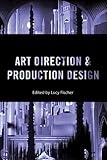Art Direction and Production Design / ed. by Lucy Fischer.
Material type: TextSeries: Behind the Silver Screen SeriesPublisher: New Brunswick, NJ : Rutgers University Press, [2015]Copyright date: ©2015Description: 1 online resource (232 p.) : 11 color and 36 black-and-white photographsContent type:
TextSeries: Behind the Silver Screen SeriesPublisher: New Brunswick, NJ : Rutgers University Press, [2015]Copyright date: ©2015Description: 1 online resource (232 p.) : 11 color and 36 black-and-white photographsContent type: - 9780813564371
- 791.4302/5
- online - DeGruyter
| Item type | Current library | Call number | URL | Status | Notes | Barcode | |
|---|---|---|---|---|---|---|---|
 eBook
eBook
|
Biblioteca "Angelicum" Pont. Univ. S.Tommaso d'Aquino Nuvola online | online - DeGruyter (Browse shelf(Opens below)) | Online access | Not for loan (Accesso limitato) | Accesso per gli utenti autorizzati / Access for authorized users | (dgr)9780813564371 |
Frontmatter -- Contents -- Acknowledgments -- Introduction -- 1. The Silent Screen, 1895–1927 -- 2. Classical Hollywood, 1928–1946 -- 3. Postwar Hollywood, 1947–1967 -- 4. The Auteur Renaissance, 1968–1980 -- 5. The New Hollywood, 1981–1999 -- 6. Hollywood’S Digital Back Lot, 2000–Present -- Academy Awards For Best Art Direction -- Notes -- Selected Bibliography -- Notes On Contributors -- Index
restricted access online access with authorization star
http://purl.org/coar/access_right/c_16ec
How is the look of a film achieved? In Art Direction and Production Design, six outstanding scholars survey the careers of notable art directors, the influence of specific design styles, the key roles played by particular studios and films in shaping the field, the effect of technological changes on production design, and the shifts in industrial modes of organization. The craft’s purpose is to produce an overall pictorial “vision” for films, and in 1924 a group of designers formed the Cinemagundi Club—their skills encompassed set design, painting, decoration, construction, and budgeting. A few years later, in recognition of their contributions to filmmaking, the first Academy Awards for art direction were given, a clear indication of just how essential the oversight of production design had become to the so-called majors. The original essays presented in Art Direction and Production Design trace the trajectory from Thomas Edison’s primitive studio, the Black Maria, to the growth of the Hollywood “studio system,” to the influence of sound, to a discussion of the “auteur theory,” and to contemporary Hollywood in which computer-generated imagery has become common. By 2000, the Society of Motion Picture Art Directors became the Art Directors Guild, emphasizing the significance of the contributions of art direction and production design to filmmaking. Art Direction and Production Design is a volume in the Behind the Silver Screen series—other titles in the series include Acting, Animation, Cinematography, Directing, Editing and Special/Visual Effects, Producers, Screenwriting, and Sound.
Mode of access: Internet via World Wide Web.
In English.
Description based on online resource; title from PDF title page (publisher's Web site, viewed 03. Jan 2023)


